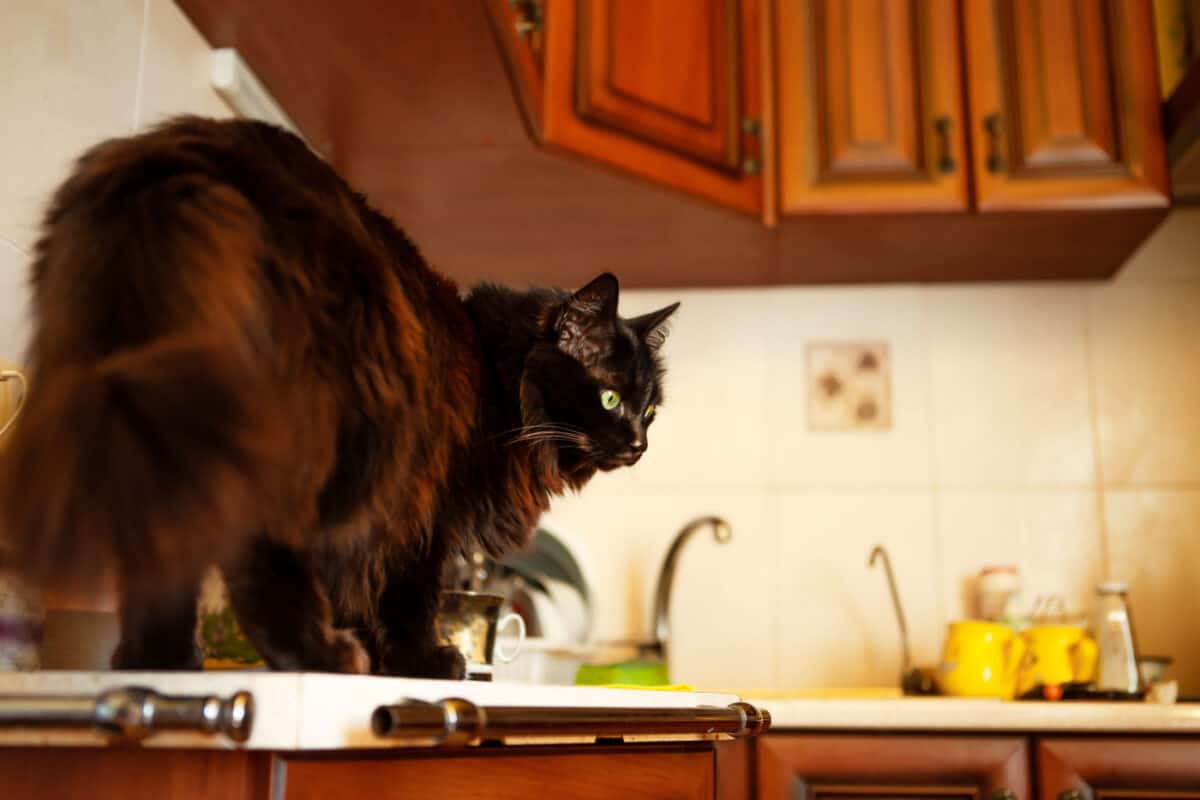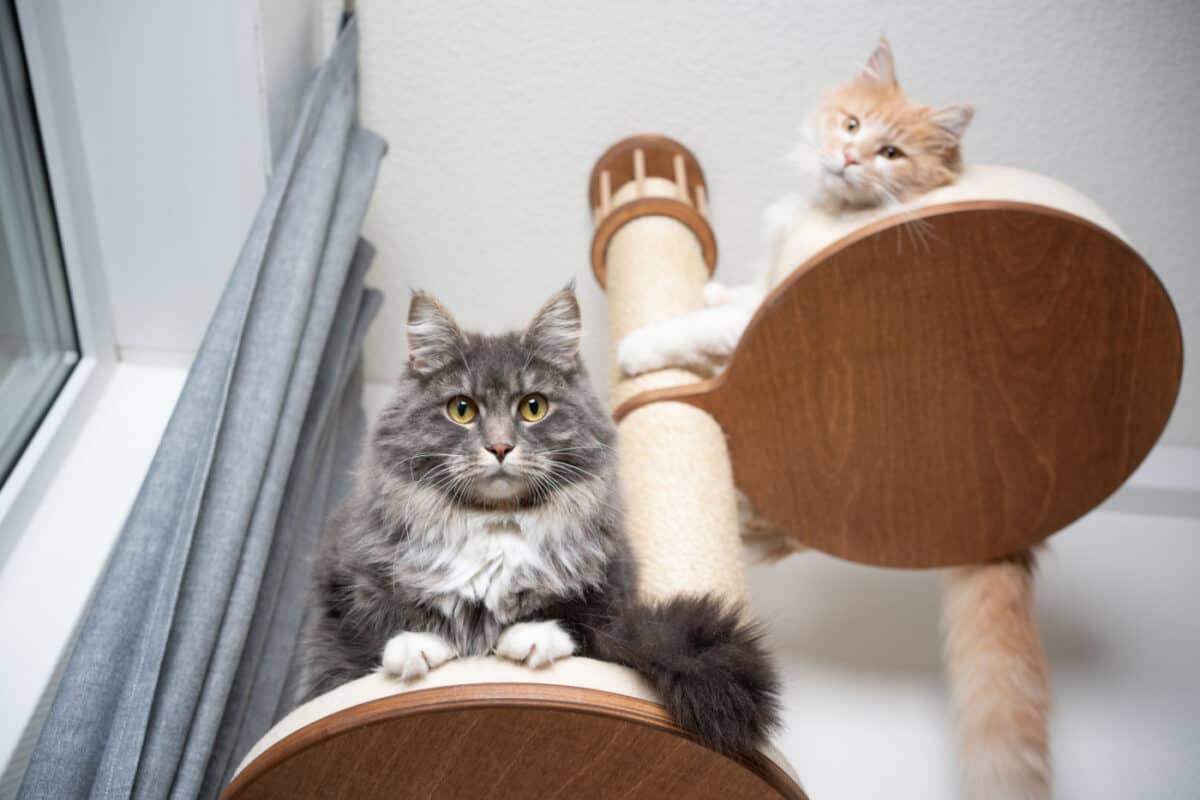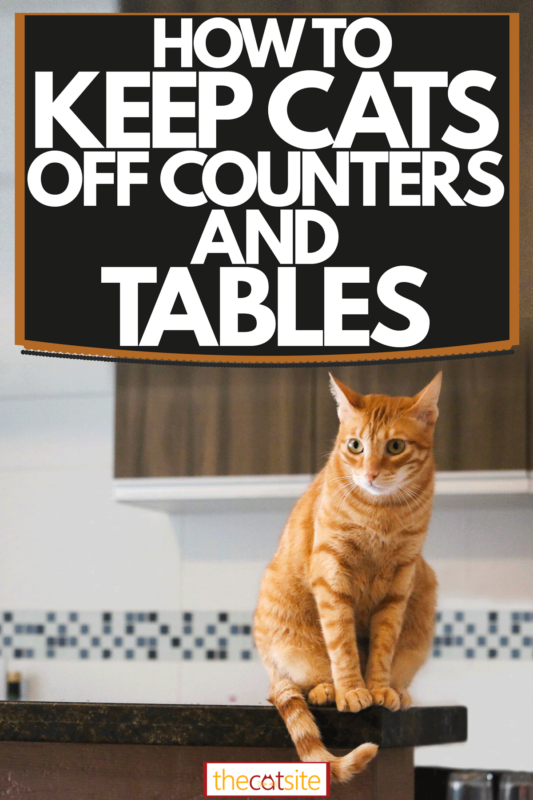Are you tired of constantly battling with your feline friend to keep them off the kitchen counters?
You're not alone.
Many cat owners have experienced the frustration of finding their furry friends perched atop the counters. In this article, we'll explore effective strategies for preventing cats from jumping on counters and keeping them safe.
But first, let's take a closer look at the scenario. The following story is based on posts shared on our cat forums.
Picture this:
you're sound asleep, dreaming of sunny beaches and endless pina coladas, when you're suddenly jolted awake by a blood-curdling scream.
It's your partner, and he's just caught your beloved cat red-handed - or should we say, red-pawed - lapping up his chocolate milk from the kitchen counter.
You're instantly filled with dread, as you know chocolate is toxic to cats. You rush to the kitchen, heart racing, only to find your furry friend looking up at you with a look that says, "What? I was thirsty." You can't help but wonder: how on earth do I keep my cat off the counters?
We get similar stories on our forums all the time.
Fortunately, there are things you can do to prevent Kitty - or whatever your furry friend's name may be - from jumping on the kitchen counters or dining tables!
There are also things you need to avoid, though. For example, spraying your cat with water may seem like an easy solution, but it can actually be counterproductive in the long run. Plus, it's not very pleasant for your cat.
We're here to help with the dos and don'ts of teaching your cat to stay off the tables and kitchen counters!
With the right strategies, patience, and consistency, you can train your cat to respect your boundaries and keep them safe from dangerous foods and objects. So, let's dive into the tips and tricks that will keep your countertops cat-free and your furry friend happy and healthy.
Why Do Cats Jump on Tables and Kitchen Counters?
Jumping to gain access to high places is a natural instinct for cats, as it allows them to survey their surroundings and feel safe.

However, as a responsible pet owner, you need to ensure that your cat's jumping behavior doesn't put them in harm's way. Kitchen counters, for example, can harbor dangerous objects and foods that can harm your feline friend. That's why it's important to teach your cat to stay off the counters and keep them safe.
But before you start limiting your cat's access to certain areas, make sure they have plenty of climbing and exploring space within your home.
Investing in cat trees, gyms, and shelves can provide your furry friend with the vertical space they need to feel comfortable and happy.

This stage is crucial! Denying your cat adequate climbing space can result in stress, frustration, and even more behavioral issues down the road.
If you're not sure how to make more vertical space for your cat, don't worry! We have some creative ideas that will make your home feel bigger and more exciting for your felines.
Why Negative Reinforcement Isn't the Answer for Keeping Cats off Counters
Before we move on to positive reinforcement methods, let's talk about why negative reinforcement and punishment are not the best ways to teach your cat to stay off counters.
Negative reinforcement, associating a negative outcome with undesirable behavior, is often used to keep cats off counters.
However, it can be stressful and even traumatic for your cat and may create new behavioral problems or worsen existing ones. Therefore, it's best to avoid negative reinforcement methods altogether.
SIGN UP FOR THECATSITE'S EMAIL UPDATES >
Some common negative reinforcement methods for keeping cats off counters include:
Water squirting
This involves using a spray bottle to squirt water at your cat when they jump on counters. However, this method can associate you with punishment, lacks consistency, and can be too stressful for most cats.
Read more: 5 Reasons To Never Spray Water On Your Cat [Or otherwise punish them]
Can shaking/compressed air can
This method involves making a loud and disturbing noise by shaking an empty soda can with coins inside or using a compressed air can.
However, it can also associate you with punishment, creates a big problem with continuity, and can bring about a strong stress response in many cats.
"Booby-trapping" your counters
This method involves setting up obstacles on the counter that will startle your cat if they jump up. Examples include using empty soda cans filled with coins or beans tied together or setting up mousetraps on the counter covered with a sheet of newspaper or towel.
While this method may be more consistent, the loud noise can be too startling for some cats, causing them to become stressed instead of trained.
So, what's the solution?
Positive reinforcement is a much more effective and humane way to teach your cat the behaviors you want them to exhibit. In the next section, we'll cover some positive reinforcement methods that can help you teach your cat to stay off counters in a way that's both effective and gentle.
The Sticky Solution: How to Keep Your Cat off Counters and Tables
If you're looking for a simple and effective way to keep your cat off the kitchen counters and tables, you might be surprised at how easy it can be.
And the best part? You won't need to resort to startling your furry friend with loud noises or sudden movements. More about that in a minute.
The secret to teaching Kitty to stay off the counters:
Make the surface uncomfortable to walk on.
One option is to use plastic carpet runners with points facing up, or you can try using double-sided adhesive tape.
Don't worry - you won't have to stick any tape directly onto your counters. Instead, you can create your own sticky mat by covering a thick plastic sheet with double-sided tape. Then, whenever you're not using the counters, just cover them with a sheet of plastic.
If you prefer to tape directly onto surfaces, regular adhesive tape works well too. Just create small loops of tape with the adhesive on the outside of the ring, and place them across the surface. This creates a similar effect of a sticky surface, but it's easier to lift off than double-sided tape.
The end result is that the surface becomes uncomfortable for your cat to walk on. They might try jumping up once or twice, but soon they'll realize it's not a pleasant experience and they'll jump off. Within a few days to a couple of weeks, your cat should stop jumping on the treated surfaces altogether. And the best part? You don't even have to be around for this to work! The consistent negative reinforcement from the sticky surface will be enough to teach your cat to stay off the counters.
It does take some effort, but the payoff is worth it. You'll have a trained cat without creating any new behavioral problems. So why not give this method a try and see how it works for you and your furry friend?
The Solution that Works for You and Your Cat
Negative reinforcement can be very effective as a way to teach your cat what not to do. Hopefully, this article has provided a better understanding of how negative reinforcement works and why some methods, such as can shaking, water squirting, and booby-trapping, should not be used.
Remember that you must always provide your cat with plenty of space, including appropriate vertical space for climbing and jumping. Only then can you implement the sticky surface method. Be consistent and give it time. Some cats can take up to three weeks to stop trying.
It can be a long journey, but we're here for you!
Why not start a thread in our cat behavior forums and let us know about your progress?
SIGN UP FOR THECATSITE'S EMAIL UPDATES >
Comments? Leave them using the comment section below. Questions? Please use the cat forums for those!

Note: We may get commissions for purchases made through links on this page.




35 comments on “How To Keep Cats Off Counters And Tables”